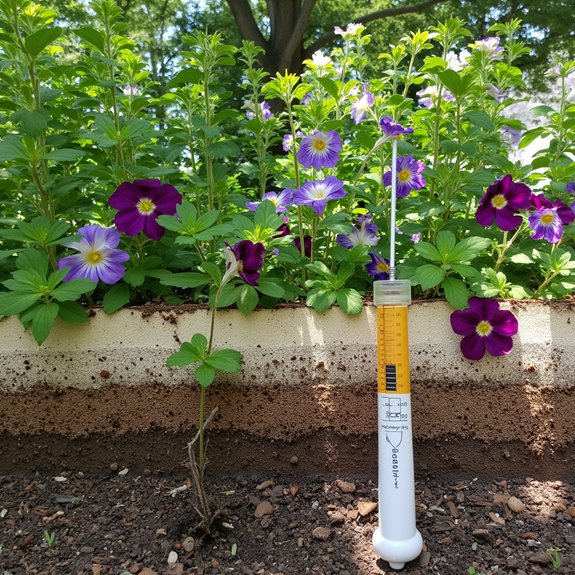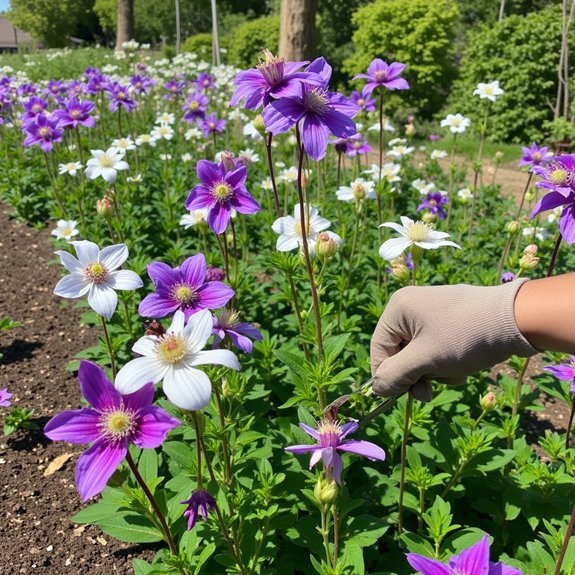You’ve probably admired columbines in other gardens, wondering why your attempts don’t match their graceful beauty. These delicate perennials aren’t as forgiving as typical garden flowers, and they’ll quickly show you when conditions aren’t right. Success requires understanding their specific needs, from soil pH to light exposure, plus mastering techniques that most gardeners overlook. The difference between thriving columbines and struggling plants often comes down to three critical factors that determine whether you’ll enjoy years of stunning blooms.
Contents
- 1 Understanding Columbine Varieties and Their Unique Characteristics
- 2 Propagation Methods: Seeds vs. Division Techniques
- 3 Optimal Growing Conditions and Soil Requirements
- 4 Essential Watering and Fertilization Practices
- 5 Seasonal Maintenance and Deadheading Strategies
- 6 Common Pest and Disease Management
- 7 Creative Garden Design and Companion Planting Ideas
- 8 Maximizing Blooms and Ensuring Long-Term Success
Understanding Columbine Varieties and Their Unique Characteristics

When you’re browsing through columbine varieties, you’ll discover that these Aquilegia species offer an impressive range of colors, shapes, and sizes to suit virtually any garden design. With approximately 70 species worldwide, horticulturalists have developed unique hybrids that showcase remarkable diversity.
You’ll find stunning color variations like Dark Purple and White columbine’s rich contrast, or Strawberry Ice Cream’s blush pink blooms that fade to white. McKana Giant Mix provides upward-facing flowers in multiple shades, while William Guinness features dramatic black-purple exteriors with white interiors. Colorado’s state flower displays classic purple-blue sepals paired with white petals.
Propagation Methods: Seeds vs. Division Techniques
Once you’ve selected your preferred columbine varieties, you’ll need to choose between two primary propagation methods: growing from seed or dividing existing plants. Seeds offer the easiest approach, as columbines naturally self-sow throughout your garden. For seed saving, collect dried flowers in late summer, then sow indoors during late winter or outdoors in early spring. Division timing proves trickier since columbines have fragile root systems that don’t handle disturbance well. While division’s possible, it’s not recommended. Seeds provide better success rates and allow cross-pollination, creating exciting color variations in your garden.
Optimal Growing Conditions and Soil Requirements

After establishing your propagation method, you’ll want to focus on creating the ideal environment for your columbines to thrive. These adaptable perennials prefer well-draining soil, making sandy conditions ideal while heavy clay spells trouble.
You can improve dense clay by mixing in compost and sand for better drainage. Soil pH isn’t particularly fussy, but neutral to slightly acidic works best.
For light exposure, aim for partial shade to full sun depending on your variety. Morning sun with afternoon shade keeps plants happy, especially in hotter climates where full sun can stress them out.
Essential Watering and Fertilization Practices
Proper watering keeps your columbines healthy without drowning their delicate roots. Water frequently during early growth, then reduce watering frequency to once weekly once established. Summer heat demands extra attention, especially for plants in full sun. Watch for wilting foliage or drooping stems, which signal water deficiency.
Most columbines don’t need additional fertilization types in quality soil. Apply slow-release fertilizer in early spring if your soil lacks nutrients. Compost works better than chemical fertilizers, improving soil structure while providing gentle nutrition. Avoid overwatering in dense soils to prevent root rot.
Seasonal Maintenance and Deadheading Strategies

Since columbines bloom throughout spring and summer, regular deadheading becomes your most important seasonal task. Remove spent flowers by cutting stems back to the first set of leaves, encouraging continuous blooms throughout the growing season. These deadheading techniques prevent unwanted self-seeding while redirecting energy into new flower production.
Seasonal pruning differs from regular deadheading. In late fall, cut entire plants back to ground level after foliage yellows naturally. This timing allows plants to store energy in their roots for next year’s growth. However, if you want natural reseeding, leave some spent flowers intact until seeds disperse completely.
Common Pest and Disease Management
While regular maintenance keeps columbines healthy, you’ll occasionally encounter pests and diseases that require prompt attention. Effective pest identification starts with checking leaf undersides for leaf miner eggs, which create telltale trails through foliage. Remove visible eggs immediately, or apply neem oil for chemical control.
Disease prevention focuses primarily on powdery mildew, a fungal infection spreading rapidly during warm, dry conditions. Prune affected leaves promptly to prevent spread throughout your garden. While organic fungicides work, they can impact neighboring plants and soil health, so use them sparingly and only when absolutely necessary.
Creative Garden Design and Companion Planting Ideas
Columbines transform any garden space through strategic placement that showcases their unique flower shapes and varied heights. Shorter varieties work perfectly as border plants, filling gaps between larger perennials. You’ll create stunning colorful combinations by pairing dark purple William Guinness with white companion plants like sweet alyssum or candytuft.
Taller varieties shine when interplanted with hostas, ferns, or astilbe in partially shaded areas. McKana Giant Mix adds vibrant garden aesthetics alongside delphiniums or lupines in cottage-style designs. You can also plant columbines behind shorter perennials, allowing companion plants to provide afternoon shade while maintaining visual depth throughout your garden beds.
Maximizing Blooms and Ensuring Long-Term Success
Strategic placement and thoughtful companions set the stage, but consistent maintenance practices determine whether your columbines will deliver maximum blooms year after year. Regular deadheading throughout the growing season encourages continuous flowering, extending bloom timing from spring into summer. You’ll notice growth patterns shift as plants mature, with second-year specimens producing more robust flower displays.
Weekly watering during establishment, followed by deep weekly soaks, supports vigorous growth. Apply slow-release fertilizer each early spring to fuel bloom production. Allow some flowers to go to seed for natural propagation, ensuring your columbine display continues indefinitely through self-sowing.
